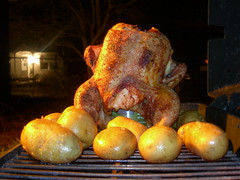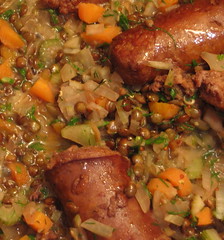
I have been intrigued by the concept of beer can chicken for some time. I made the plunge and was shocked at how easy and tasty this was. Besides just looking really cool - how many meals can you think of where a beer can is inserted into the orifice of the main course? I'll stop here and answer that question - hopefully not many, but in this case - the technique is more than just for show. There are a number of chicken grilling issues solved by this method --
- The beer steams the chicken from the inside while the skin is crisped nicely by the dry heat of the grill
- The fat just runs off the bird - you chicken isn't swimming in a pool of fat during the cooking process
- The thighs and legs get the cooking time they need, while the breasts get nice and tender without being overcooked
There are a number of variations on how to cook and flavor the bird. For my first pass, I used the instructions and basic rub from Steven Raichlen who popularized the technique - but you're only limited by your imagination and the immediate availability of ingredients. I wouldn't be surprised if you saw a recipe for an Asian styled version posted here sometime in the near future.
Ingredients
# 1 large whole chicken (3 to 4 pounds)
# 3 tablespoons Basic Rub for Barbecue or your favorite dry barbecue rub
# 1 can (12 ounces) beer - I used a beer from a local brewery - Top of the Hill "Trophy Lager" since it is one of the best tasting canned beers around in my opinion.
Directions
1. Remove and discard the fat just inside the body cavities of the chicken. Remove the package of giblets, and set aside for another use. Rinse the chicken, inside and out, under cold running water. then drain and blot dry, inside and out, with paper towels. Sprinkle 1 tablespoon of the rub inside the body and neck cavities, then rub another 1 tablespoon all over the skin of the bird. If you wish, rub another 1/2 tablespoon of the mixture between the flesh and skin. Cover and refrigerate the chicken while you preheat the grill.
2. Set up the grill for indirect grilling, placing a drip pan in the center. If using a charcoal grill, preheat it to medium. If using a gas grill, preheat the grill to high; then lower the heat to medium.
3. Pop the tab on the beer can. Using a "church key"-style can opener , make 6 or 7 holes in the top of the can. Drink a few slugs of beer, leaving about 2/3 of the can full - then spoon the remaining dry rub into the beer. Holding the chicken upright, with the opening of the body cavity down, insert the beer can into the cavity.
4. When ready to cook, if using charcoal, toss half the wood chips on the coals. Oil grill grate. Stand the chicken up in the center of the hot grate, over the drip pan. Spread out the legs to form a sort of tripod, to support the bird.
5. Cover the grill and cook the chicken, until fall-off-the-bone tender - a 3- 4lb bird takes about 1hr and 15 minutes.
6. Using tongs, lift the bird to a cutting board or platter, holding a large metal spatula underneath the beer can for support. (Have the board or platter right next to the bird to make the move shorter. Be careful not to spill hot beer on yourself.) Let stand for 5 minutes before carving the meat off the upright carcass. (Toss the beer can out along with the carcass).
This is the recipe for the basic rub -
1. Combine ingredients in a bowl, and whisk them all together to mix.
2. Store in an airtight jar.
Yield: 2 cups.
All in all - this was one of the tastiest chickens I've eaten - and we eat a bunch of chicken. This one gets 5 big stars and will definitely be rolled out on a regular basis.


